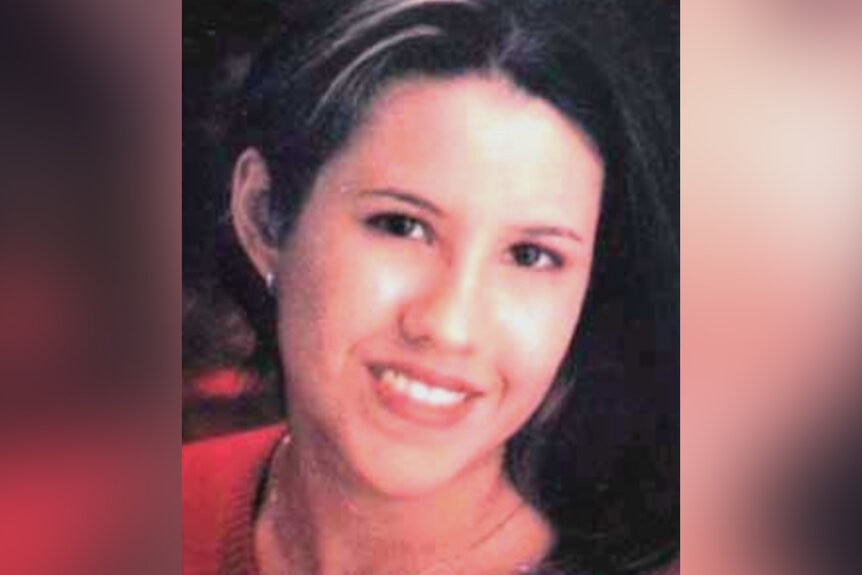Create a free profile to get unlimited access to exclusive videos, breaking news, sweepstakes, and more!
‘The Body Was Ice Cold’: NYC Bar Bouncer Raped, Strangled Grad Student
Imette St. Guillen, a shining criminology grad student, was bar-hopping with friends in Soho one night in 2006. By morning, she was dead.
On February 25, 2006, a 911 call reporting a grisly discovery in a remote area of Brooklyn frequented by sex workers would eventually lead to one of the city’s most unsettling murder cases.
Det. Christopher Debernardo, NYPD, 75th Precinct, Brooklyn, arrived on the scene and observed what appeared to be a body wrapped in a blanket.
“I do remember checking for a pulse. The body was definitely ice cold,” he told Oxygen series “New York Homicide."
The victim was 24-year-old graduate student Imette St. Guillen. Packing tape covered her face, she was nude, and her hands and feet were bound with Zip Ties. A red speck that looked like blood, possibly hers or the killer’s, was on one of the ties. A snow brush near her body was collected as evidence.
An autopsy revealed St. Guillen died by asphyxiation. She had had a sock shoved into her mouth and been sexually assaulted, according to detectives. Red fibers were found on the tape when it was removed from her face.
Investigators learned that St. Guillen grew up in Boston and graduated from George Washington University. An exuberant high-achiever, she came to NYC to earn a master’s degree in criminology at John Jay College.
Detectives pieced together St. Guillen’s movements before her murder. On the night of February 24 she had gone bar-hopping with friends, including Claire Higgins, in the trendy Soho neighborhood to celebrate St. Guillen’s upcoming birthday. She decided to stay out after her friends went home.
“You've got a victim who was drinking heavily and alone,” said Robert K. Boyce, former NYPD chief of detectives. “It seems very likely someone noticed this and took advantage.”
Higgins told police that a bartender at the Pioneer Bar on Bowery and Spring Street had hit on St. Guillen that night and she rebuffed him. Detectives followed up on the lead and were able to clear him as a suspect. They also looked into the victim’s ex-boyfriend, who they off the list of suspects after interviewing him and tracing his whereabouts using phone records.
Police scoured recent cases to see if any were similar to St. Guillen’s. They noted that on February 12 a woman who had been sexually assaulted by an unofficial cab driver was dumped out of a vehicle less than a mile from where St. Guillen was found.
“We brought that victim in,” said Det. Mark Brooks, NYPD, 75th Precinct, Brooklyn. “We were able to get a detailed description.”
A sketch of the cab driver was released, and not long after, police got a surprising visit from a man who identified himself as the cab driver who had committed the assault on February 12. But he insisted he had nothing to do with the St. Guillen murder. He claimed that he was in New Jersey on the night that St. Guillen was found. He provided detectives with his DNA, as well as contacts for passengers that night. Police retraced his travels using cell phone data, and it turned out the cab driver’s phone came nowhere near the crime scene.
Detectives had hit a dead end in the case, but a new lead emerged when they obtained St. Guillen’s financial records. They showed that she had used her debit card at The Falls, a bar on Lafayette Street within walking distance from Pioneer.
They interviewed the bar manager, who, they recalled, said he’d seen her but didn’t take much notice. He was “standoffish and not cooperative,” said Det. Sean McTighe, NYPD, Brooklyn North Homicide Squad. They proceeded to question bartenders, customers, and the bouncer. One bartender recalled serving St. Guillen, while the bouncer told authorities he didn’t recognize her from their photo.
When investigators dug deeper, they got an unexpected reminder of the 1986 Preppy Murder. In that salacious case, Robert Chambers strangled Jennifer Levin in Central Park after seeing her at the Manhattan bar Dorrian’s Red Hand. The Falls’ manager Danny Dorrian’s father ran Dorrian’s Red Hand. Did Danny Dorrian know more than he was telling investigators? Was he involved in the homicide? Police sought warrants to search the Falls.
On March 3, six days into the investigation, Danny Dorrian came to the police station with his attorney to speak with detectives. He said that he did recall St. Guillen at the bar because she didn’t want to leave even after “last call.” He had his bouncer, Daryl Littlejohn, escort her out.
Littlejohn had told investigators that he didn’t recognize St. Guillen’s photo. Considering the circumstances and the fact that he had to personally take her out of the establishment, this raised suspicions.
When police reinterviewed him, Littlejohn, a career criminal on parole, changed his story. He claimed that seeing St. Guillen’s picture in the newspaper jogged his memory, investigators told producers.
“He was very forthcoming,” said McTighe. “His thing was, ‘I walked her out of the bar and I went my way and she went her way.’” Littlejohn added that he drove a van, the same type of vehicle a watchman had seen in the area where St. Guillen was dumped the night of the murder.
Police were able to put Littlejohn behind bars as they continued to investigate the case because he had violated his parole agreement by not being in his residence by 10 p.m. They began by obtaining and analyzing his cell phone records, which put him in the remote Brooklyn area where St. Guillen was found.
They then got a warrant to search Littlejohn’s home. They immediately saw red carpeting and recalled the fibers on the tape that had been wrapped around St. Guillen’s face. Analysis proved the carpet fibers were a match, and that the blood on the Zip Ties binding the victim belonged to Littlejohn. Touch DNA on the snow brush was also a match.
The pieces of the case were coming together. Shanai Woodard, a student who was following the case on the news, saw images of Littlejohn’s van. She told police that in October 2005 he had posed as law enforcement and then abducted her. He’d handcuffed her and drove away with her in the back of his vehicle, but managed to open the car door and escape by tumbling out of the van.
Police matched saliva found in Littlejohn’s van to Woodard’s. In 2008, he was convicted of kidnapping and unlawful imprisonment and sentenced to 25 years to life.
In July 2009, Littlejohn was found guilty of raping and murdering Imette St. Guillen. He was sentenced to life in prison without parole, reported the New York Times.
Despite the strange connection that both murders happened after the victims had been at bars run by the Dorrian family, detectives found no evidence that Danny Dorian had anything to do with the murder of St. Guillen, said Boyce.
To find out more about this case including how the victim changed NYC laws, watch “New York Homicide" on Oxygen, or you can stream episodes here.























